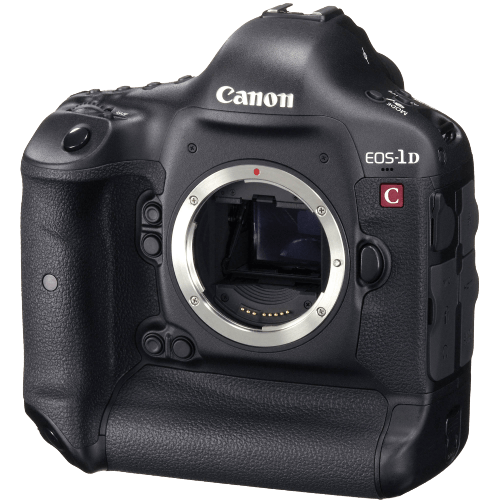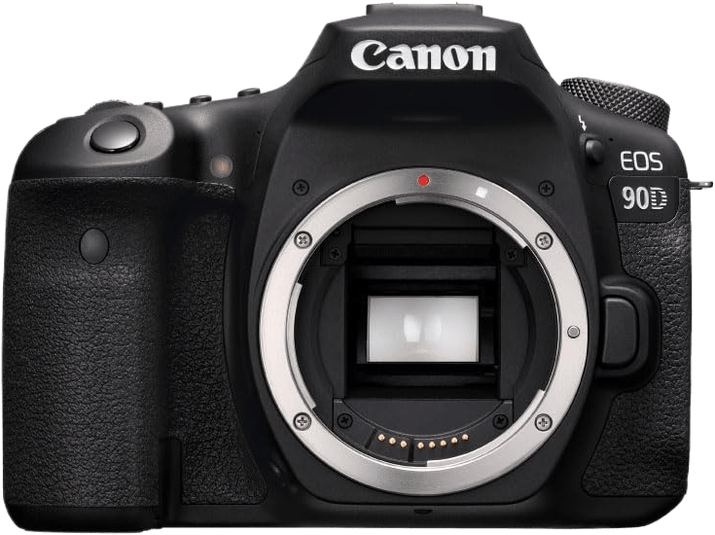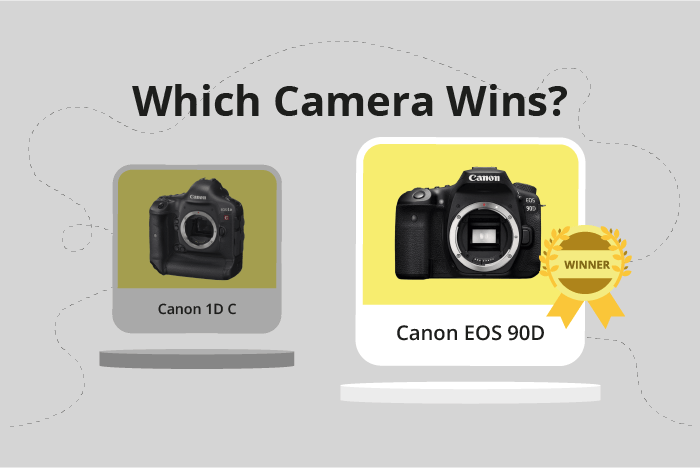Canon 1D C vs EOS 90D Comparison
Canon 1D C

Canon EOS 90D

The Canon EOS 90D outperforms the Canon 1D C with a score of 67 to 60. Both cameras are DSLRs, with the 1D C announced in 2012 and the EOS 90D in 2019. They share similarities in their camera type and core specifications.
The EOS 90D proves to be a better camera in terms of its higher score, more recent release, and lower launch price of $1199 compared to the 1D C’s $15,000. Additionally, the EOS 90D is lighter and smaller, with dimensions of 141 x 105 x 77mm and a weight of 701g, making it more portable and user-friendly.
On the other hand, the Canon 1D C may still have some advantages despite its lower score, such as better build quality, given its larger size and heavier weight of 158 x 164 x 83mm and 1545g. However, this comes at a significantly higher cost.
Taking these factors into account, the Canon EOS 90D emerges as the more practical and cost-effective option for most users, while the Canon 1D C could be suitable for those who prioritize build quality and durability.
Canon 1D C vs EOS 90D Overview and Optics
The Canon EOS 90D wins in the optics comparison with a score of 62/100, while the Canon 1D C scores 56/100. Both cameras share several specifications, including a CMOS sensor, no image stabilization, and compatibility with Canon EF lenses. However, there are key differences that contribute to the higher score of the EOS 90D.
The EOS 90D has a higher megapixel count at 33 compared to the 1D C’s 18 megapixels. This means the 90D can capture more detail and produce higher resolution images. Additionally, the 90D has a more advanced image processor, the Digic 8, which enhances image quality and performance.
On the other hand, the 1D C has a full-frame sensor, while the 90D has an APS-C sensor. The full-frame sensor of the 1D C allows for better low-light performance and a wider dynamic range. The 1D C also has a higher DXOMARK score for the sensor at 81, compared to the 90D’s 58. Furthermore, the 1D C has a faster shooting speed of 14 frames per second, which is advantageous for action and sports photography.
Despite these advantages, the 1D C still falls short in overall optics performance. The EOS 90D’s higher megapixel count, advanced image processor, and compatibility with both EF and EF-S lenses make it the better choice for most photographers. Although the 1D C excels in certain areas, such as low-light performance and shooting speed, the EOS 90D proves to be the superior camera in terms of optics.
Canon 1D C vs EOS 90D Video Performance
The Canon EOS 90D outperforms the Canon 1D C in video capabilities, scoring 91/100 compared to the 1D C’s score of 83/100. Both cameras share some common specifications, such as 4K video resolution and built-in time-lapse functionality. However, the EOS 90D surpasses the 1D C with its higher maximum video frame rate and slightly different video dimensions.
The EOS 90D’s maximum video frame rate is 120fps, which is double the 1D C’s 60fps. This higher frame rate allows for smoother slow-motion footage and more flexibility in post-production. Additionally, the EOS 90D has video dimensions of 3840 x 2160, while the 1D C has dimensions of 4096 x 2160. The difference in dimensions is minimal, but it may affect the final output format and compatibility with certain displays or video players.
On the other hand, the 1D C does have a slightly wider aspect ratio due to its 4096 x 2160 dimensions, which may be preferable for some filmmakers. However, this advantage is not significant enough to outweigh the EOS 90D’s higher video score and superior frame rate.
In comparing the video capabilities of the Canon 1D C and the Canon EOS 90D, the EOS 90D emerges as the better option. Its higher video score, faster maximum frame rate, and comparable dimensions make it the more versatile and powerful camera for videographers. While the 1D C does have a slightly wider aspect ratio, it falls short in other critical areas, making the EOS 90D the clear winner in this comparison.
Canon 1D C vs EOS 90D Features and Benefits
The Canon EOS 90D emerges as the winner with a feature score of 83/100, compared to the Canon 1D C’s score of 72/100. Both cameras share certain specifications, such as a screen resolution of 1,040,000 dots and Bluetooth connectivity. However, the EOS 90D surpasses the 1D C in other aspects, contributing to its higher score.
The EOS 90D’s superiority lies in its touchscreen capabilities, flip screen, and WiFi connectivity. The touchscreen allows for easier navigation and control, while the flip screen provides flexibility in capturing photos and videos from different angles. WiFi connectivity enables seamless sharing of images and remote control of the camera.
On the other hand, the Canon 1D C has a larger screen size of 3.2 inches, compared to the EOS 90D’s 3-inch screen. This difference may provide a better viewing experience for some users. Additionally, the 1D C includes GPS functionality, which the EOS 90D lacks. This feature allows users to geotag their images, which can be useful for organizing and locating photos based on location data.
Despite the advantages of the Canon 1D C, the EOS 90D remains the better camera due to its higher feature score. The touchscreen, flip screen, and WiFi capabilities make it a more user-friendly and versatile option. While the 1D C has a larger screen and GPS functionality, these features may not be as crucial to the majority of users. Therefore, the Canon EOS 90D is the recommended choice for those seeking a camera with superior features and functionality.
Canon 1D C vs EOS 90D Storage and Battery
The Canon EOS 90D outperforms the Canon 1D C in storage and battery with a score of 48/100 compared to 45/100. Both cameras have one memory card slot and lack USB charging capabilities. The 90D accepts SD, SDHC, and SDXC memory cards, including UHS-II compatibility, offering more flexibility in storage options. Additionally, the 90D has a longer battery life with 1300 shots per charge, using the LP-E6N battery.
In contrast, the 1D C only accepts Compact Flash (Type I or II) memory cards and has a shorter battery life of 1120 shots, using the Lithium-Ion LP-E4N battery. While the 1D C falls short in this comparison, its battery life is still sufficient for most photographers.
The Canon EOS 90D offers better storage options and longer battery life, making it a more convenient choice for photographers. The Canon 1D C, although not as strong in this category, still provides adequate battery life for most users.
Canon 1D C vs EOS 90D – Our Verdict
Are you still undecided about which camera is right for you? Have a look at these popular comparisons that feature the Canon 1D C or the Canon EOS 90D:

